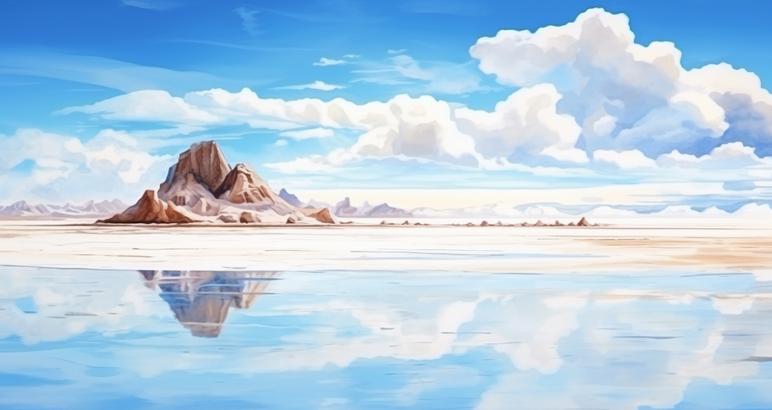The Surreal Landscapes of Bolivia's Salar de Uyuni

A Journey Through Time and Space
It all started with a simple question: What does it feel like to walk on the moon? While I certainly have no intention of becoming an astronaut, the thought of experiencing an otherworldly environment led me to the enchanting Salar de Uyuni in Bolivia. This ethereal landscape, also known as the world's largest salt flat, spans over 4,000 square miles and provides an unparalleled experience for all who traverse its seemingly infinite expanse.A Picturesque Setting for Space Travel Enthusiasts
If you've ever dreamed of strolling across the surface of the moon while sporting a jaunty hat instead of the more traditional space helmet, then you're in luck. Salar de Uyuni's unique terrain almost seems to have been plucked directly from a science-fiction film; its vast, white salt crust is dotted with mysterious mounds and punctuated by the occasional cacti, providing visitors with the perfect setting for their own lunar expedition. And, while there's a noticeable lack of extraterrestrial life (or any life for that matter), the eerie silence certainly adds to the mystique of this spectacular destination.How to Get There: A Quest for the Less Adventurous
While the journey to Salar de Uyuni may not be as treacherous as traversing the cold, desolate vacuum of space, it does have its fair share of challenges. The salt flat is located in southwestern Bolivia, near the crest of the Andes, and thus requires some effort to reach. Most travelers opt for a guided tour, which departs from the nearby town of Uyuni. However, if you prefer to blaze your own trail, you can rent a 4x4 vehicle and set off into the white unknown (while, of course, adhering to all local regulations and guidelines).Before embarking on your adventure, keep in mind that the Salar de Uyuni is not your average tourist destination. There are no convenient snack stands or souvenir shops, so be sure to pack plenty of water, food, and layers to keep warm during the chilly nights.
Visiting the Lunar Landscape: What to Do and See
Once you've arrived at the Salar de Uyuni, you might find yourself questioning the very fabric of reality. As you gaze upon the seemingly endless expanse of white, the lines between sky and earth blur, and it's not uncommon to feel as though you've stepped into a Salvador Dalí painting. However, there are several notable landmarks that serve as reminders that you are, in fact, still on planet Earth:- Island of Incahuasi: A rocky outcrop rising from the salt flat, Incahuasi is home to a forest of towering cacti and offers panoramic views of the surrounding landscape.
- Train Cemetery: Located just outside of Uyuni, this graveyard of abandoned locomotives is a haunting reminder of the region's industrial past.
- Tunupa Volcano: This dormant volcano looms over the salt flat, creating a striking contrast between its dark slopes and the blindingly white salt crust.
Witnessing the Magic: The Salar in Different Seasons
Seasonal changes in weather can drastically transform the appearance of Salar de Uyuni, providing visitors with a completely different experience depending on when they choose to visit. During the dry season, from May to November, the salt flat boasts a hard, cracked surface that stretches as far as the eye can see. This is the perfect time to experiment with perspective photography, as the stark contrast between the white salt crust and the deep blue sky makes for stunning visuals.On the other hand, the wet season, which typically occurs between December and April, sees the Salar de Uyuni transformed into a giant mirror. A thin layer of water covers the salt flat, creating a surreal, reflective surface that seamlessly blends the sky and the earth. Sunset and sunrise are particularly mesmerizing during this time, as the vivid colors of the sky are mirrored perfectly on the ground below.
A Final Thought: The End of the Universe?
As you stand amidst the vast white expanse of Salar de Uyuni, you might find yourself pondering the nature of existence itself. Is this seemingly infinite salt flat truly the end of the universe, or perhaps just the beginning? Regardless of your existential conclusions, one thing is certain: a visit to this surreal landscape will leave you with memories that are truly out of this world.Article kindly provided by myfavouritehols.com
Latest Articles
- How to Plan Around Peak Congestion Days for Mountain Trips
- Mapping Your First Mountain Resort Loop Without Losing Your Sanity
- How Pro Kitchen Renovations Quietly Increase Booking Confidence in Self-Catering Stays
- Discover a City's Real Character From the Backseat
- How to Make Airport Layovers Surprisingly Productive
- From HVAC to ROI: the Hidden Economics of Sustainable Hotel Design
- How to Plan Your Day Tours to Minimize Crowds and Maximize Serendipity
- From Tourist to Observer: How to Photograph a City Like a Local
- Seasonal Shifts in Abandoned Turkish Valleys Reveal Clues About Heritage Site Decay
- Mastering Group Travel Planning for Events in Fort Lauderdale
- Beyond the Beach Bus: Hidden Palm Beach Spots Worth the Group Ride
- Chrono-Travel and Time Zone Acrobatics on a Coach
- Hidden Miami Charter Bus Routes to Secret Beaches, Local Food Gems, and Underrated Attractions
- More Than Just Ice - Unexpected Events at Amerant Bank Arena
- Madrid's Strangest Museums and Attractions You Never Knew Existed
- Disaster-Proof Rentals: A Flood-Resilient Guide for Holiday Homeowners
- Following the Footsteps of Filmmakers: Morocco's Iconic Movie Locations You Can Visit
- Hidden Gems Along Morocco's Coastline
- Tastes of Miami: Culinary Tours for the Global Foodie
- Milwaukee's Hidden Green Gems: Nature's Best Kept Secrets

